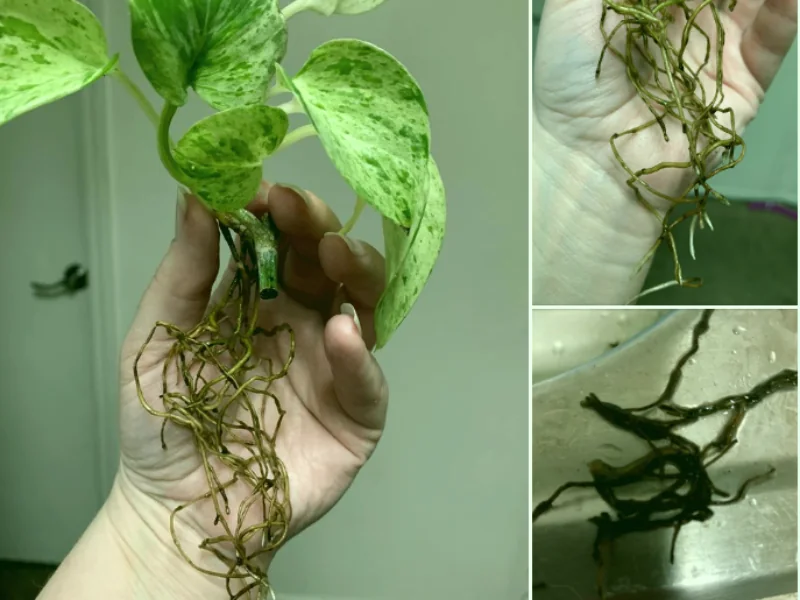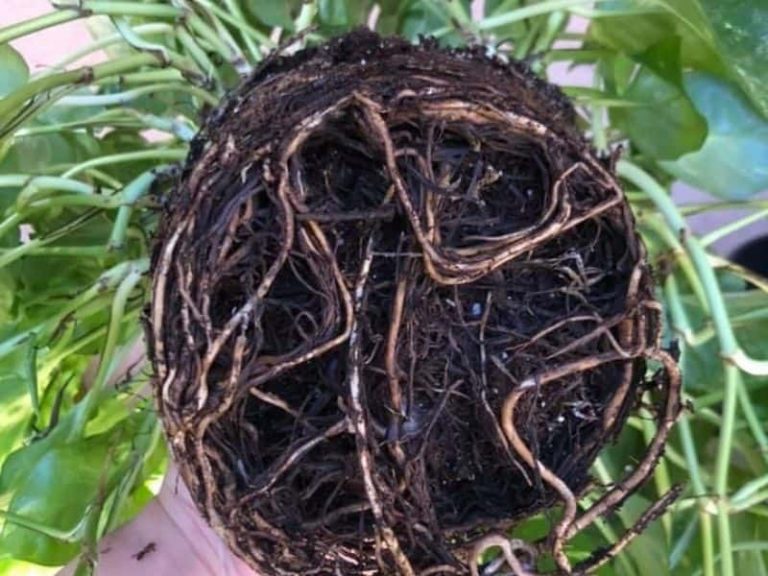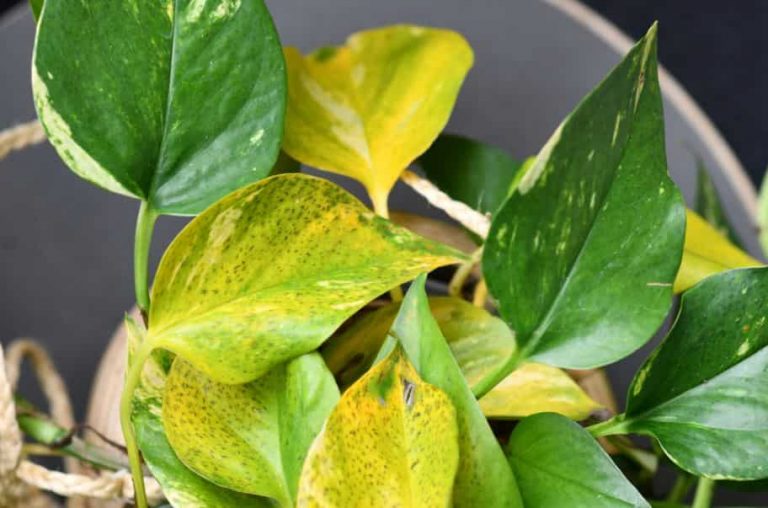Pothos Root Rot – Signs, How to Save + Treat Pothos

Root rot is a fungal disease that affects the roots of plants – both in pots and outdoors. If your pothos is growing in a container without proper drainage holes or in waterlogged soil, it is at risk of root rot disease.
So, what does root rot look like pothos, and how do you save the plant?
Root rot in pothos is caused by a fungus that becomes active in soggy conditions from overwatering the plant. Its signs include yellowing leaves, drooping, and rotting roots. Cut off the decaying roots, treat the remaining ones with weak hydrogen peroxide, then repot the pothos to save it.
Root rot can also affect pothos growing in water. The roots will turn brown and mushy, and the leaves will droop and turn yellow.
Signs of root rot in pothos
Note that if you do not treat root rot, the plant will die because of the inability to take in water, oxygen, and nutrients for survival.
Here’s how to tell your pothos has root rot:
Leaves turning yellow
Rotting roots cannot absorb water, nutrients, and oxygen to feed the plant. The deficiency of these nutrients can make the leaves of pothos turn yellow, droop, and wilt.
Also, pothos leaf yellowing caused by root rot is usually characterized by random yellow stripes all over the leaf; rather than on one side, as is the case with leaf yellowing caused by overexposure to sunlight.
However, leaf yellowing in pothos can occur for other reasons, such as excessive direct sunlight and older leaves. Remove the plant from its pot to check the condition of its roots.
Roots rotting and turning black
Another major sign of root rot in pothos is the roots changing color to black and rotting. If you unearth the plant from the pot, check to see whether the roots are black and soggy; a surefire sign of root rot.
Remove pothos from the pot and check the roots for the following symptoms of root rot:
- Affected roots may fall off when you touch them.
- Roots feel mushy and weak.
- The roots appear to be black and rotting.
The worst affected roots tend to easily dislodge from the plant, unlike healthy roots, which are usually firm. Therefore- if the mushy, black/brown roots on your pothos aren’t pliable and pull off easily from the plant, you’re most likely dealing with a case of root rot. Healthy pothos roots should feel firm.
Foul smell
A rotten egg smell coming out of your plant’s pot is a sign the roots are rotting, possibly due to overwatering.
You can also identify root rot from the decaying smell that comes from the roots. Healthy roots tend to have an earthy smell, so if that’s not the case, chances are your plants’ roots are decaying.
What causes root rot in pothos?
The two major causes of root rot in pothos are overwatering and soil fungi. However, additional causes exist as discussed below.
Pothos sitting in water
If you overwater your plants, the soil won’t drain the water fast enough. This excess water deprives the roots of much-needed oxygen, leading to root decay.
If the pothos has been sitting in water for too long, you’ll likely see root rot symptoms because of the inability to breathe and translocate water and nutrients.
Fungi
Soil-inhabiting bacteria are the main cause of root rot in pothos and other indoor plants.
If the soil on which you grow your plants has poor drainage, it’s likely to stay wet for long after every watering session. This creates a suitable habitat for soil fungi, which feed on the nutrients and the roots, making them rot.
How to save pothos from root rot
The best way to treat root rot and save pothos is to remove the plant from the pot, trim off the affected roots, and then treat the remaining healthy roots with hydrogen peroxide. Repot the plant afresh and provide enough soil moisture.
Here’s an elaborated process of treating root rot in pothos:
1. Remove the pothos from the pot
Carefully remove the plant from its pot. Place one hand on top of the potting soil (base of the plant). Using the other hand, tip over the plant and the pot so that the soil and the pothos slide out of the container.
If the plant does not come out easily, tap the sides of the planter to loosen the soil first and then do the procedure. Avoid pulling the plant out of the soil as this will tear the weak roots.
2. Clean the roots with running water
After unearthing the plant, run some water through the roots to remove soil around the roots.
Cleaning will remove as much of the slimy coating as possible, exposing the roots for proper examination and for easy identification of the soft, worst-affected roots.
3. Cut off the mushy, rotting roots

Cut off any decaying roots to prevent the fungal disease from spreading to other unaffected roots. The easiest way is to identify black or brown, mushy roots that are affected by the fungal disease.
Clean the scissors every time you cut the roots, or simply disinfect them using a hydrogen peroxide solution to prevent spreading the fungal disease to healthy roots.
4. Treat the roots with hydrogen peroxide
Dip the remaining healthy roots of your pothos plant in a 3% hydrogen peroxide solution to kill the fungus.
Also, sterilize the plant’s pot using the hydrogen peroxide solution before adding new potting soil to it for repotting.
5. Repot the pothos afresh
The last step in treating pothos root rot is to repot the plant with a new potting mix. Keep in mind that pothos like well-draining soil. After repotting, shift to a mild watering schedule as you observe the plant. Allow the soil to dry between watering sessions to prevent waterlogging.
You may also want to place it in a place where it receives medium natural sunlight.
Pro tip: Prune off any yellowing or wilting pothos leaves. You may also need to prune off about half the pothos foliage to increase the chances of root regrowth by lessening the need to support all the leaves. Also, keep in mind that if identified too late, the root rot may be too advanced, and your chances of saving your pothos plants will be minimal. Therefore, early identification and treatment is critical.
If you notice leaf wilting and a few black, mushy roots but with no decaying smell just yet; it could be that your root rot problem is at its earlier stages. In such instances, simply let the wet soil dry out.
Stop watering your pothos until the soil is dry.
Can a potted plant recover from root rot?
The chances of potted plants surviving root rot depends on how early treatment begins. To help your potted pothos plants recover from root rot, use remedies like hydrogen peroxide, which boosts soil oxygen levels and helps ward off soil fungal infestations.
You’ll also want to replace the soil type in your pot with one that has good drainage. Alternatively, add perlite to improve the soil’s drainage.
As the plant recovers, avoid applying fertilizer, as this may adversely affect your pothos.
How long does it take pothos to recover from root rot?
How fast your plant will heal depends on the conditions in the pot. To save your pothos faster:
- Use a proper container size depending on the the size of the roots.
- Use clay containers/pots that allow for side evaporation.
References
- David J. Norman and G. Shad Ali, The University of Florida, IFAS Extension: Pothos (Epipremnum aureum) Diseases: Identification and Control in Commercial Greenhouse Production
- University of Massachusettes Umass Extension: Pothos – Phytophthora crown rot


![Pothos vs. Philodendron: Differences [Pictures + Identification]](https://gardenine.com/wp-content/uploads/2020/12/Pothos-vs-Philodendron-leaf-shape-and-texture-768x576.jpg)



![Pothos Leaves Curling [Causes + Easy Ways to Fix Leaf Curl]](https://gardenine.com/wp-content/uploads/2020/11/Pothos-leaves-curling.jpg)

Before my plant journey, I was told pothos are very easy to care for. I’ve had 3 pothos so far and they have all died on me.
Root rot is usually the reason.
Question: if the roots are a tan-ish or light brown in color, is it root rot?
I know that may be an obvious yes but I’m struggling here. I bought 2 golden pothos at Lowe’s today, very root bound and a light brown in color.
Some have very white tips, some didn’t.
I LOVE THE POTHOS . Especially the marble queen.
I just want to keep them alive to enjoy them.
Thanks!
Light brown and tan are completey normal; black and dark dark brown are bad, also they would be mushy to touch if they are rotten.
Root rot will be black and mushy. If you think it’s on its way to root rot, touch the roots.
If its mushy, then yes it is root rot.
Water them less and maybe try giving them more sun just to dry out the soil.
Hi! I’m trying to save my neighbors satin pothos. I’m pretty sure that it has pretty bad root rot but also all of the leaves (just about) have fallen off of the vines and/or are turning a very light yellow. He told me that he thought it had root rot so he left it outside for a week in direct sunlight which is what I think made it much worse. I was planning on going through the whole process mentioned above but also should I cut the vines back as well so that it grows normally again? At this point, it’s basically just got long bare vines with a few rotten yellow leaves. It’s such a pretty plant and I want to save it!
Thanks
Today, I had to clean root rot from my two golden pothos plants and disinfect their roots and containers in hydrogen peroxide. Both plants are grown in water. Should I change their water every week in order to prevent another fungal infection?